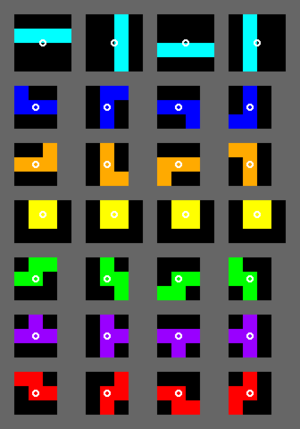Super Rotation System: Difference between revisions
*>Nicholas No edit summary |
|||
| Line 1: | Line 1: | ||
[[Image:SRS-pieces.png|thumb|All rotation states of all seven tetrominoes. From top to bottom: I, J, L, O, S, T, Z. The circle doesn't appear in the game; it helps to illustrate the axis on which each tetromino rotates.]] | [[Image:SRS-pieces.png|thumb|All rotation states of all seven tetrominoes. From top to bottom: I, J, L, O, S, T, Z. The circle doesn't appear in the game; it helps to illustrate the axis on which each tetromino rotates.]] | ||
'''''Super Rotation System''''', or '''''SRS''''' is the current [[Tetris Guideline]] standard for how [[tetromino|tetrominoes]] behave, in a broad sense. SRS represents where and how tetrominoes spawn, how they [[rotate]], and what [[wall kick|wall kicks]] they may perform. In [[Tetris The Grand Master 3 Terror-Instinct|TI]], a player may choose between ''World'' and ''Classic'' rotation styles. ''World'' closely resembles SRS, and ''Classic'' closely resembles the rotation styles of its predecessors [[Tetris The Grand Master|TGM]] and [[Tetris The Absolute The Grand Master 2|TAP]]. [[Henk Rogers]], in his effort to unify all new Tetris games into the Tetris Guideline, required [[Arika]] to include SRS, which is called ''World'' in Ti. SRS traces its routes back to 1991 when [[BPS]] introduced its signature third and fourth | '''''Super Rotation System''''', or '''''SRS''''' is the current [[Tetris Guideline]] standard for how [[tetromino|tetrominoes]] behave, in a broad sense. SRS represents where and how tetrominoes spawn, how they [[rotate]], and what [[wall kick|wall kicks]] they may perform. In [[Tetris The Grand Master 3 Terror-Instinct|TI]], a player may choose between ''World'' and ''Classic'' rotation styles. ''World'' closely resembles SRS, and ''Classic'' closely resembles the rotation styles of its predecessors [[Tetris The Grand Master|TGM]] and [[Tetris The Absolute The Grand Master 2|TAP]]. [[Henk Rogers]], in his effort to unify all new Tetris games into the Tetris Guideline, required [[Arika]] to include SRS, which is called ''World'' in Ti. SRS traces its routes back to 1991 when [[BPS]] introduced its signature third and fourth [[orientation]]s for the ''S'', ''Z'', and ''I'' tetrominoes in their [[Tetris 2 and Bombliss|Tetris 2+Bombliss]]. Later would come flipped-side-up spawned ''T'', ''L'', and ''J'' tetrominoes and flexible new wall kicks. Probably the most accurate SRS finds itself in BPS's latest games [[Tetris Worlds]] and [[Tetris Deluxe]], which both feature exact same rotation styles. | ||
==Description== | ==Description== | ||
Revision as of 20:47, 17 November 2006

Super Rotation System, or SRS is the current Tetris Guideline standard for how tetrominoes behave, in a broad sense. SRS represents where and how tetrominoes spawn, how they rotate, and what wall kicks they may perform. In TI, a player may choose between World and Classic rotation styles. World closely resembles SRS, and Classic closely resembles the rotation styles of its predecessors TGM and TAP. Henk Rogers, in his effort to unify all new Tetris games into the Tetris Guideline, required Arika to include SRS, which is called World in Ti. SRS traces its routes back to 1991 when BPS introduced its signature third and fourth orientations for the S, Z, and I tetrominoes in their Tetris 2+Bombliss. Later would come flipped-side-up spawned T, L, and J tetrominoes and flexible new wall kicks. Probably the most accurate SRS finds itself in BPS's latest games Tetris Worlds and Tetris Deluxe, which both feature exact same rotation styles.
Description
All tetrominoes exist inside a bounding square and rotate about the center of this square unless obstructed. Tetrominoes of width 3 (J, L, S, T, Z) are placed in the top two rows of the bounding square and (for J, L, and T) with the flat side down. I is placed in the top middle row.
All tetrominoes spawn in 2 usually hidden rows at the top of the playfield. They are placed in the center of these rows, rounding to the left.
Once a tetromino lands, it does not lock until the lock delay expires. The lock delay is reset whenever the tetromino is moved or rotated (even O, which ordinarily does not rotate). This controversial feature allows a single tetromino to be easily kept "alive" forever. To reduce the negative effects of this, newer Tetris games tend to have modes that reward play speed, such as points per minute or garbage per minute. These modes encourage use of the hard drop (generally mapped to Up), which has no lock delay.
Wall kicks in SRS are extremely flexible compared to those of earlier games. Some rotations result in new positions that do not overlap the former position at all, allowing for highly controversial T-spin triples (see Twists).
20G
Since Henk Rogers has never been directly involved with a game boasting 20G, certain behaviors are likely undefined in the Tetris Guidelines. Tetris Worlds approaches 20G but reportedly never attains it. TGM3 and TGM ACE are the first and second games to support 20G and SRS, and Tetris DS (TDS) is the third. Though the rotations are identical, these games have different mobility restrictions due to their different order of processing events in between frames.
In this example, Left is being held and then a clockwise rotation is initiated.
|
|
|
The above example ends mid-frame... So the figure on the right is never actually rendered. It simply represents the internal game status after rotation has been processed.
Now, if the game processes movement followed by gravity, the following scenario will happen (as found in TGM3).
|
|
|
On the other hand, if gravity is processed next, the following scenario will happen (as found in TDS). This could be the result of either movement processed after gravity, movement processed before rotation, or (most likely in the case of TDS) movement occurring one or more frames after both rotation and gravity due to slow DAS.
|
|
|